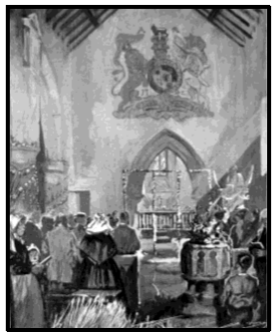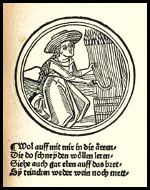Some medieval theologians and parish priests saw divine intervention in agrarian fortunes and used familiar harvest experience to acquaint parishioners with higher truths revealed in the Scriptures. The faithful heard sermons about Jesus’ parables of the sower, wheat and tares, mustard seed, and leaven—all four found in Matthew 13, in which the temporal realm of crops and barns and harvests represented profound spiritual happenings and fates. These and other parables were subjects of an extensive series of engravings by French artist Léonard Gaultier (1561-1641). The influential Dutch artist Hieronymus Bosch (c. 1450-1516) depicted such allegories in complex paintings of detailed fantasy also known for his use of colorful impasto. Among the best known of some sixteen surviving Bosch triptychs are the masterful The Garden of Earthly Delights and The Path of Life. Both works are held by Madrid’s Museo del Prado and may have been used as altarpieces usually opened to glorious effect on feast days. They were likely painted between 1500 and 1505 in the time when Old World conceptions of humanity’s place on earth was giving way to new understandings made possible by Columbus’ trans-Atlantic discoveries.
Heironymus Bosch, The Path of Life Center Panel, The Haywain ( c. 1505)
Oil and tempura on wood; 53 x 79 inches (tryptich)
Museo del Prado, Madrid; Wikimedia Commons
The centerpiece of The Path of Life, known as The Haywain, is flanked by an image of Eden on the left and the Last Judgement to the right to provide a visual narrative sequence rich in detail of humanity’s fate apart from vigilant faith. The heavily laden hay wagon dominates the view of workers too busily engaged in the affairs and frivolity of daily life to consider Christ’s overview from the clouds above. Wagon and passengers are pulled toward destruction by a team of infernal beings while others eat, drink, and be merry. Bosch derived the conception from Jesus’ explanation of the Parable of the Tares of the Field in Matthew 13:37-39 which concludes, “…the harvest is the end of the age; and the reapers are the angels.” Bosch’s visionary art influenced the Brueghels, David Teniers the Younger (1610-1690), and others whose own styles marked the emergence of the Northern Renaissance.
Works by the notable Flemish artist pair Joachim Patinir (c. 1480-1524) and Quentin Massys (1466-1530) evidence imaginative spatial variety with agrarian settings in service to biblical narratives popular in the late medieval and Renaissance. Patinir, for whom story was as indispensable as setting composed the landscapes while Massys painted the more detailed human figures in the foregrounds. These elements are seen in their most ambitious paintings of apocryphal The Miracle of the Wheat Field, also known as Rest on the Flight into Egypt, which are comprised of scenes during the Holy Family’s escape from King Herod. Mary asked a peasant farmer to tell the pursuing Roman soldiers—portrayed as dullards, that they had long since the mature grain would cause the pursuers to think too much time has passed to continue. The farmer can be seen speaking to the soldiers, and because he had helped the fugitives, the field appears miraculously transformed into a crop of ripened bounty visible on the right side of the several versions attributed to Patinir’s worship and painted between 1515 and 1524.
Georges Trubert and Simon Bening, The Flight into Egypt (c. 1485 and c. 1530)
Tempera colors with gold leaf on wood (showing the “Miracle of the Wheat” in background)
J. Paul Getty Museum, Los Angeles. Used by permission.
Patinir and Massys’s renderings evoke compassion for the sufferings of Mary, Joseph, and Jesus, and are remarkable for the detailed harvest scenes showing teams of field workers with their tools and livestock, other tillage operations like plowing and harrowing, and the remarkable height and appearance of landrace grains. Because neither Patinir, Massys, nor their Northern Renaissance contemporaries like Simon Bening (c. 1483-1561) and Georges Trubert (1469-1508) had ever visited the Holy Land, such immense panoramas appear more colorfully exotic with towering blue-green mountains and verdant valleys than actually exist in the Low Countries. Trubert, a French illuminator, is known for panels enhanced by intense red-oranges, lapis azures, deep garnet, and other dramatic colors. Patinir’s oil panels are also more imaginatively composed and with naturalistic depth than other paintings of the time, and mark the emergence of European landscape art as a distinct genre imbuing place with as much significance as people. But only in the early eighteenth century would landscape art acquire the modern sense of depicting the countryside for its own sake.







![G. Freman, P[eter]P. Bouche (engraver), Boaz espouseth Ruth; From Richard Blome, History of the Holy Bible (London, 1688), 7 ⅛ x 12 ¾ inches](https://images.squarespace-cdn.com/content/v1/577c39f56b8f5bec285fe33f/1551929267350-3QUNNT7OP9JJ5MJ3W4U6/RuthBoaz.jpg)




